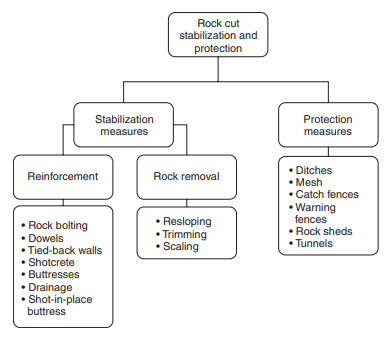I've recently been commissioned to carry out the geotechnical investigations and remedial design of engineering solutions for a rock-slide which now places a structure at risk.
The situation is that a major office block development was built approximately 10 years ago to encroach within 7' of an abandoned quarry highwall (near-vertical cliff face, estimated height 100'). The face of this quarry highwall has recently spalled off, detaching along a joint set parallel to its crest, which has led to tension cracks opening up in the asphalt immediately behind the highwall. The nearest structural columns are just 7' behind the highwall crest and about 4' behind the nearest tension cracks. Columns are undoubtedly supported on bases bearing onto rock.
I attach two photographs showing the situation- an elevation of the failed highwall and a profile immediately behind its face showing the existing columns. The tension cracks are located intermittently between the existing columns and the top of the highwall (which coincides with the boundary fence-line). The cracks are not particularly wide at this stage, but run perfectly parallel to the crest of the failed highwall, suggesting to me that a further joint set has opened up behind the face.
The bedrock geology is Tillite- it is well jointed but has no bedding to speak of.
I'm contemplating the best investigation methodology to use in this instance, and also the kind of engineering solution that might be required to stabilize the rock face, assuming the current failure has opened up a further joint set immediately behind the face. I was leaning toward a drone inspection of the highwall face, perhaps supplemented by orientated triple-tube core boreholes through the existing asphalt at the crest of the highwall.
Practically, I'm wondering how one might go about anchoring such a rock face beneath the structure. I have yet to inspect the site myself, but I foresee all sorts of challenges to the investigation, design and construction.
Any guidance, opinions or similar experiences would be most welcome.
Cheers,
Mike
The situation is that a major office block development was built approximately 10 years ago to encroach within 7' of an abandoned quarry highwall (near-vertical cliff face, estimated height 100'). The face of this quarry highwall has recently spalled off, detaching along a joint set parallel to its crest, which has led to tension cracks opening up in the asphalt immediately behind the highwall. The nearest structural columns are just 7' behind the highwall crest and about 4' behind the nearest tension cracks. Columns are undoubtedly supported on bases bearing onto rock.
I attach two photographs showing the situation- an elevation of the failed highwall and a profile immediately behind its face showing the existing columns. The tension cracks are located intermittently between the existing columns and the top of the highwall (which coincides with the boundary fence-line). The cracks are not particularly wide at this stage, but run perfectly parallel to the crest of the failed highwall, suggesting to me that a further joint set has opened up behind the face.
The bedrock geology is Tillite- it is well jointed but has no bedding to speak of.
I'm contemplating the best investigation methodology to use in this instance, and also the kind of engineering solution that might be required to stabilize the rock face, assuming the current failure has opened up a further joint set immediately behind the face. I was leaning toward a drone inspection of the highwall face, perhaps supplemented by orientated triple-tube core boreholes through the existing asphalt at the crest of the highwall.
Practically, I'm wondering how one might go about anchoring such a rock face beneath the structure. I have yet to inspect the site myself, but I foresee all sorts of challenges to the investigation, design and construction.
Any guidance, opinions or similar experiences would be most welcome.
Cheers,
Mike

